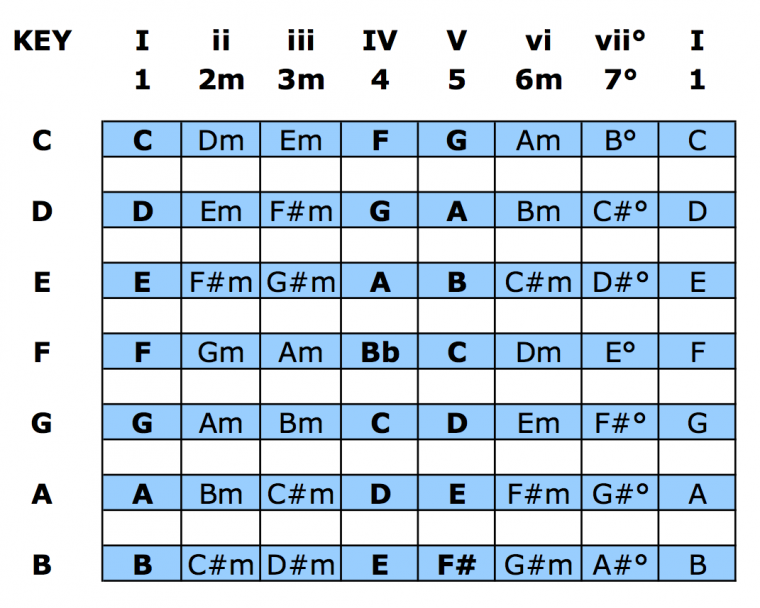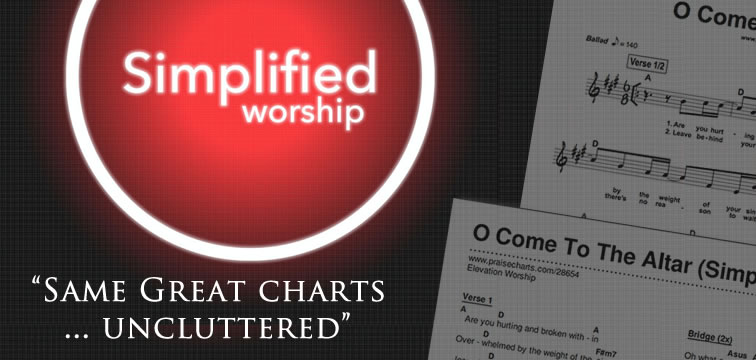The Nashville Number System Chart For Bands
Featuring Dan Wilt Posted on July 3, 2014
You’ve probably had the experience – you’re in the middle of a rehearsal, and you need to change the key of that song. “Should I or shouldn’t I?” you silently ask yourself. You must. You simply must. So, sheepishly you suggest that the song must be put into a different key. You brace yourself for you band’s reaction – and you really wish you had this chart to give them.
When a band is asked to change keys on the fly, 3 things inevitably happen:
- Smiling – The professional musicians smile, and turn their chart over. No biggie. They think they can just play it by ear. But you changed some of the chords from what they might “intuit” should happen next in the verse. You’ll have to shout them out as they play. Can you say, “train wreck?”
- Jaw-Dropping – The able musicians, who are not professionals, drop their jaws, grab their pens and frantically begin to scratch out the old chords in the old key to replace them with the new chords. They use their fingers to count out loud in order to figure out which chord comes next.
- Crying – The inexperienced musicians just sit down, cry, and occasionally glare up at you with a menacing look.
The Nashville Number System: A Basic Approach
There is a better way, and it’s called The Nashville Number System (NNS). I’ve created a very basic version of it for handing out to your teams to get you started– here is the PDF Download of the NNS Chart. Musicians all over my city use the NNS in the studio and in live settings to communicate musical changes quickly.
The basic principle is this. Each chord in a key has a number assigned to it. Many songs are fairly simple in their chord structure. In my world of worship music, this is often the case.
The I chord (1), IV chord (4), V chord (5), and vi (6m) chord are the most common. I won’t get into all the details here, but if you know these chords for one key, in your head, you are ready to go.
Example In The Key Of G
Study the chart above as you read this next part.
First if a song is in the key of G, and you see the G (I), the C (IV), the D (V), and the Em (vi), you have your chords. Now, as an exercise, print out the chart and use white out to change the G chord to the number 1 (which is the same thing as the Roman numeral I), the C chord to the number 4 (IV), D to the number 5 (V), and Em to 6m (vi – lower case means the chord is minor rather than major).
Done? Now play the song, memorizing the numbers rather than the chords. Now, you are ready to transpose.
Look at the chart. Go to the key of D. The D is the 1, the G is the 4, the A is the 5, and the Bm is the 6m. Simply play the chords as numbers, in the same spots as the others. Then, start trying to play the song, just based on the numbers in a few other keys.
Now, take a few songs that are very familiar to you and change the chords to the numbers in the chart below. Practice until the numbers for each key start to get in your craw.
After a few weeks,, this will start to be a huge game changer.
Start Talking In Numbers In Rehearsal
Get your musicians familiar with hearing you say numbers instead of chords. If you’re in the key of G, and you want the team to go to the C chord, say “to the 4″ rather than “go to C.” Do this over months, and the band will start to get it. If they memorize their I, IV, V, and vi chords for each key, you’re most of the way there.
Once you all learn the Nashville Number System, changing keys (and playing better by ear) will seem infinitely easier.
Recommended Resource: Nashville Number System (NNS) Video and PDF Tool. A free download of the chart only is available here. WorshipTraining hosts my 7-minute Video and PDF Nashville Number System Tool with which you can now train your band.
Article by Dan Wilt - original article found here
Tags: Nashville Numbers System, Worship Resources
Related Posts
- 5 Reasons Lament And Praise Must Stand Together In Worship
- Secrets To Recording & Promoting An Indie Worship Album - Webinar with Matt McCoy
- 8 Ways A Worship Leader Can Be A Good Host At Rehearsal
- 7 Best Practices For Running A Great Worship Rehearsal
- Building A Culture Of Worship & Songwriting with Vertical Church Band
- With You We Walk A New Year Prayer For Churches
- 3 Keys To Leading A More Meaningful Life In The New Year
- The Fraction Principle How To Make Beautiful Music By Playing Less
Other Posts Featuring Dan Wilt
- On Epiphany: The Manifestation
- On Pentecost: The Spirit's Coming
- My Response To “8 Reasons The Worship Industry Is Killing Worship”
- Moving Toward God With Doxology
- 5 Reasons Lament And Praise Must Stand Together In Worship
- 8 Ways A Worship Leader Can Be A Good Host At Rehearsal
- My Response To “5 Reasons Jimmy Fallon Is One Of The Best Worship Leaders In The World”
- 7 Best Practices For Running A Great Worship Rehearsal
